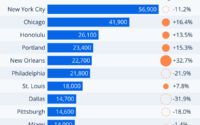The Money Doctor who has slayed inflation for 50 years says the Fed has overcorrected and will cause a recession
Economist Steve Hanke has forged a 50-year career as a global “money doctor,” advising heads of state and finance ministers from Indonesia to Kazakhstan. He’s currently working with two presidential candidates in South America to quash inflation: In Venezuela, Roberto Enriquez, the Christian democratic party COPEI’s nominee for the 2024 election, has engaged Hanke as a chief economic advisor charged with designing a currency board. In Argentina, aides to libertarian party candidate Javier Milei, who will run to lead the nation in October, are consulting Hanke on a blueprint to tackle a price explosion that hit 103% in March. But there’s one nation he can’t seem to help: the United States.
Today, Hanke, a professor of applied economics at Johns Hopkins University, charges that the U.S. Federal Reserve is refusing to fill the prescriptions that helped bring a combination of low inflation and robust health to sundry ailing economies. In Hanke’s view, the Fed—after adopting reckless policies bound to send prices surging then failing to see the coming wave—is now using excessive, brute force, for far too long, to slay a dragon that’s already slayed. “Inflation’s in the rearview mirror, and the Fed doesn’t even know it,” he says. “The monetary squeeze it’s now imposing is aimed at a problem that’s over, and the effect from here will be to hammer consumer demand and economic growth.”
Hanke is a leading champion of monetarism, a field holding that changes in the money supply are the top force determining the rate of inflation and expansion or contraction in GDP. Milton Friedman, its most celebrated champion and a Hanke mentor, had the monetarist formula for changes in its four components, MV = Py (money supply times velocity of money equals the price level times quantity of goods and services) emblazoned on his red Cadillac’s California license plate. As Friedman explained, “Inflation is always and everywhere a monetary phenomenon, in the sense that it can only be produced by a more rapid increase in the quantity of money than in output.” The money supply broadly measured is defined as M2, showing all money that’s readily spendable, including cash in circulation and in checking and savings deposits, as well as funds in money market accounts. Put simply, the monetarists maintain that inflation erupts when growth in M2 outpaces the rise in the output in goods and services, so that more fresh money’s sloshing around for every new car, semiconductor, or airline seat hitting the marketplace.
Hanke claims that the Fed caused the inflationary burst by ignoring the money supply, while producing it in excess. Now, it’s botching the cure by dismissing M2’s importance and squeezing too hard. “First, the Fed engineered an absolutely unprecedented explosion in M2 that Chairman [Jerome] Powell claimed would have no effect on inflation,” marvels Hanke. “The Fed put up a smoke screen about the causes, all these nonmonetary outside factors that were supposed to be responsible for the soaring CPI [consumer price index]. It was the COVID shock, the oil and OPEC shock, the war in Ukraine shock, the supply-chain shock. All of those things only affect relative prices, how prices of used cars, say, rise while the cost for appliances stays flat, not overall inflation, which is all about the money supply. You have 785 economists in the Fed system, yet none that we know of predicted the inflationary outburst.”
Now, says Hanke, the Fed is engaging in monetary whiplash. “The central bank has thrown the gears into a jarring, sudden reverse,” he says. “The Fed is using quantitative tightening, or QT, to drain the money consumers have to spend at an extremely rapid pace. At the same time, the banks are making it much tougher to get the likes of car loans or mortgages.” The reduction in credit, he says, isn’t mainly the result of the Fed’s big hike in interest rates. “Sure, that’s played a role by making loans more expensive, but raising rates guide to what’s really important, the trajectory of the money supply,” he says.
Hanke notes that in three periods since 1960, the central bank has raised the Fed funds rate to help quell an inflationary buildup, yet economic growth remained strong. For example, from 1993 to 1995 the Fed hiked from 3% to 6%, yet unemployment fell from 6.5% to 5.8%, and GDP advanced by 3% a year. “The difference from today is that during those episodes, everybody was optimistic, so demand for credit was hot. Bank lending kept the money supply growing,” says Hanke. Put simply, the economy could withstand the rate increases because both the demand and supply for credit were plentiful.
The present scenario’s as sour as those periods were buoyant, says Hanke. “Now, people are fearing a recession,” he says. “The demand for credit has gotten much weaker.” That’s half the story, he says. The other half is that the supply side, the banks’ willingness and ability to make new loans, a crucial source of liquidity, is also falling fast. “The implosion of Silicon Valley Bank and First Republic has led Fed officials to advocate for tighter regulations on midsized lenders, and stricter enforcement of existing rules. Plus, unlike the Fed, the commercial banks do watch the money supply and the liquidity associated with it. And they worry that more and more tightening will continue to suck out their deposits as the short-term Treasury rates far exceed what they’re earning on their longer-term loans, and hence what they can afford to pay customers on deposits.” As the deposit bases fall, so does their ammunition to make new loans. “You’ve got a credit crunch on the supply side and feeble demand because people are girding for a downturn,” says Hanke. “That’s the one-two punch.”
The upshot is that the Fed and the banks combined are rapidly contracting the amount of money consumers have available to purchase groceries, outdoor decking, and restaurant meals. In other words, the confluence of QT and falling credit is pummeling M2. “The money supply is falling for the only time, for the first time, since the 1948 to 1949 period,” says Hanke. (Two of the only three other declines since 1920 occurred during the Great Depression.) “But that the Fed’s still pursuing these brutal, rigid policies when inflation’s dying means the downturn might be much worse than what was already in the cards.”
The question is, if that compression is so disastrous, how come the economy’s still looking relatively strong, especially measured by robust employment and wage gains? Hanke points out that big shifts in the money supply only drive GDP and inflation at long lead times. “The Fed is ‘data dependent,’ meaning they make decisions based on what the current numbers show,” he says. “It’s the new wage and employment figures that mainly influence central bank policy. But those are ‘lagging indicators.’ The numbers only show the current trends caused by monetary forces set in motion many months before. The swings in inflation show up 12 to 24 months after the money supply moves that trigger them.”
Those delayed reactions exemplify how the Fed could get away with claiming for so long that the historic money blowout wasn’t inflationary at all. The long fuse on monetary policy also gives Powell cover to contend that our still humming economy signals that current draconian measures don’t foreshadow a sharp downturn, and that the U.S. is probably headed for a ‘soft landing.’ According to Hanke, the Fed’s past blindness on the money supply mirrors its current cluelessness to the danger ahead.
Where the Fed went wrong
Hanke was extremely prescient, and specific, in predicting virtually before any other economist that the Fed’s excessive, pandemic-driven stimulus would send prices raging. That early call lends credibility to his current forecast that the central bank’s continuing clampdown is equally extreme and misguided. For Hanke, it’s the Fed’s failure to watch and manage the money supply that’s responsible for both errors.
Hanke famously uses the example of the “monetary bathtub” to show how the inflow of too much money stokes inflation, and how too little, or none at all, causes a liquidity shortage that roils the economy. New money flows into the bathtub from two sources, Hanke notes. Those are the twin faucets pouring water into the tub. The first is the Fed. The central bank creates new money by purchasing Treasuries from individuals, as well as mortgage-backed bonds issued by Fannie Mae and Freddie Mac. The folks selling the bonds put the cash in their checking and savings accounts, which constitute the biggest part of M2, and use that money at grocery and home supply stores and amusement parks.
The second spigot feeding the money supply is bank lending. “People don’t realize it, but traditionally, most of the growth in M2 comes from banks and not the Fed,” says Hanke. “At present, the bank deposits make up a little over 82% of M2.” When banks are confident that relatively few customers will default and see good times ahead, they funnel a bigger share of their deposits into new loans. Their customers, in turn, take those dollars borrowed on their credit cards or cash-out home refis and park the proceeds in their savings and checking accounts. The banks then use that fresh money to extend still more credit, further lifting M2 in a flywheel dynamic.
The tub has two drains. The first is economic growth. We’ll call it the “G” drain. As the U.S. produces more goods and services, that expansion offsets increases in the money supply. The faster the GDP output expands relative to the new money entering the tub, the lower the inflationary water pressure. The second drain is called the “demand for money,” or the “DM” outlet. As the economy grows, people will earn and hold more money. The extra money they keep and don’t spend eases the push on prices.
If the inflow exceeds the outflow by a modest amount, you get a slowly rising accumulation that’s nothing worrisome. In fact, that scenario is consistent with achieving the Fed’s 2% inflation target. But if the two faucets are running full blast, the G and DM valves get overwhelmed, and water spews over the tub’s sides into excess inflation.
The Fed makes two wrong turns
By the summer of 2022, Hanke viewed the monetary eruption as so gigantic that inflation would remain elevated for a long time. He saw a CPI ending 2023 at about 5%. But the Fed’s sudden, severe U-turn starting last summer prompted the economist’s own abrupt reversal. Behind the shift in outlook was a double hit. The Fed was shrinking its balance sheet at record speed, far faster than Hanke had expected. At the same time, lenders were rapidly dialing back the credit spigot that had been running freely. “We haven’t had quantitative tightening on this scale since the 1930s,” declares Hanke. “Plus, credit was already falling before the Silicon Valley Bank disaster, and now it’s falling faster, with reforms on the horizon that will force lending even lower. The two forces together are cutting the consumers’ firepower to buy things.”
To see how the monetary picture has gone from flood to drought so fast, let’s get back in the tub. Since February of 2020, the cumulative increase in M2 is 33.6%. (The shrinkage via QT and lower lending has already subtracted almost 6%-plus from the 40% peak.) Now, let’s look at all the drains. GDP has increased 6.3% since early 2020, and demand for money has risen by 5.1%. And inflation’s sucked another 17% of M2. Add it all up, and only 4.7% cumulative money remains in the tub. Nothing new is entering the tub. And GDP is still positive, demand for money is still positive, and inflation is still active. So the “water level” will keep falling, starving the economy for liquidity and hastening a recession.
The rub, says Hanke, is that the Fed is still proceeding with its money-squeezing QT, at a rate of $95 billion a month, while the banks retrench. Keep in mind that the fall in the money supply operates with a long lag, just like jumps in M2. Months ago, Hanke made a new prediction that inflation would be running at between 2% and 5% by year-end. He now thinks that the number might end up at the lower end of his range.
“The bathtub is already nearly empty, and since the Fed doesn’t watch the money supply, the Fed doesn’t know it,” concludes Hanke. “If the Fed continues on this course, they’ll drain the tub, and when the tub goes empty you really have a problem.” He says that the central bank, rather than hammering M2, should be growing it modestly to avoid a recession. For the veteran campaigner, taking dollars out of people’s pockets when inflation’s headed to near zero is the definition of craziness.
Only the Fed could drown in an empty bathtub.
[ad_2]
Source link


